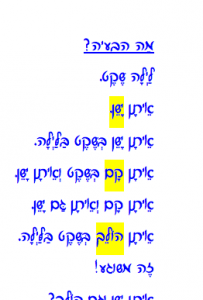You can read Part 1, “Why We Need To Legitimize Modern Hebrew,” here.
Since Hebrew programs offered in seven area public high schools are experiencing a crisis of enrollment and qualified/certified Hebrew teachers, the community response, with its best intentions, has been to advocate for saving their programs at school board meetings.
The more I explore, though, the clearer it becomes that Hebrew teacher and student shortages are a symptom of a bigger dilemma that no amount of clamoring will resolve. If we’re able to save a high school Hebrew program from the chopping block for one more year, this temporary solution will only delay the next crisis, and the program will soon end up at-risk again. Why are we having these Hebrew program stability issues?

THE CRITIQUE: Because from what I’ve seen and heard so far, the quality & consistency of these high school Hebrew offerings varies widely. And these variations aren’t unique to public high school Hebrew programs; they are, unfortunately, ubiquitous.
Some high school programs relegate the fundamental input job to a Hebrew online computer course. Some rely on a dry, grammar-heavy & outmoded text book. Some are so stretched and strained that they don’t allow a teaching setup that meets the needs of individual students and levels; still others focus on Israeli culture and Jewish identity (delivered in English), punting on their stated goal: Hebrew language proficiency. Many teachers dedicate their precious instructional minutes to teaching Hebrew linguistics – grammatical and syntactical features of the language, with a heavy emphasis on accuracy over meaning – at the expense of copious Hebrew input to build acquisition for real communication. Most don’t scaffold the language enough for the novice to comprehend messages, or map meaning of individual words. The strongest tool in the Second Language Acquisition box, READING, isn’t leveraged effectively. No Hebrew curriculum that I know of focuses on students acquiring a corpus of the highest frequency words, to afford greatest coverage. This last strategy eluded me for the first two decades of my Spanish teaching career 😳 !
THE PROPOSED SOLUTION: With the kind of material and community support we have at our disposal, we can, no doubt! shore up our Hebrew offerings. Not just the public high school programs, but all our programs. We want the highest quality early start – long sequence learning (acquiring), so let’s start thinking about coordinating the entire progression. Let’s create pre-K to 8th grade programs so effective and enjoyable that a considerable number of students will elect to continue taking Modern Hebrew in high school, and beyond! It’s not too great or too difficult a goal to fathom or accomplish. It will take energy and will, but, speaking from my experience, it’s definitely doable!

Here’s my first draft Road Map to Improving Modern Hebrew Instruction:
A. TRAIN/RE-TRAIN TEACHERS:
I was a veteran Spanish language teacher for nearly 20 years before I retooled my teaching with Comprehensible Input (T/CI). I attended workshops, got support from my administration and department colleagues (we all retrained together), and tinkered in my classroom. I read, watched demonstration videos, went to conferences, was coached by master teachers, and participated in two Professional Learning Communities (PLCs). I also visited CI-based classrooms for the best training of all – live observation and debriefing with the teacher. All these teacher-to-teacher experiences knit me into a network of inspired and inspiring colleagues, from whom I continue to learn.
I propose an 8-10 hour (total) beginners’ workshop (3-5 hours per day?) with sessions in Rationale (Second Language Acquisition) and Comprehensible Input strategies, coached skills practice, and resource assessment & development, for all stakeholders – teachers, administrators, Hebrew camp counselors & directors, etc. Such groundwork will get us ‘all on the same page,’ ready to dive into CI strategies in our classrooms/learning environments. (Read about the 8-hour Hebrew teacher training I led this summer.)
I hope to organize and lead broader Hebrew trainings this academic year, aimed at any Hebrew language teachers/levels and attended by all aforementioned stakeholders, as the basic principles (for absolute beginners through intermediate level students of any age) are the same. It would be wonderful to bring different area institutions together to host a regional training, thereby building teacher and administrator networks!
Once we are all enlightened on how the brain acquires language, and we can discern which strategies we need to dump, keep or add, we’ll be ready to…
B. ORGANIZE FOR ONGOING SUPPORT:
This step is part & parcel to training, and helps insure shared vision, consistency, and a common language experience for our students, as well as resources & materials for teachers. As we train, we group Hebrew teachers by the grade/level they teach, to build networks of colleagues across the area/country/world:
 *Elementary Pre-K to 2nd grade & 3rd to 5th grade sub-groups
*Elementary Pre-K to 2nd grade & 3rd to 5th grade sub-groups
*Middle school to junior high, 6th-8th grade
*High school & adult learners
(We can combine above groupings for many aspects of training.)
Next we form and/or participate in online users’ groups (i.e., moreTPRS Yahoo! group, Facebook ifltntprsciteaching, shared Google docs, more blogs and such,) so that teachers can support each other, sharing documents, questions and reflections in user-friendly, archive-able and searchable platforms. A YouTube channel of Hebrew teacher demonstration videos could be a tremendous resource! I’m happy to start building a repository on my blog, but let’s hope we bust out and need a different ‘file cabinet,’ because my blog can’t handle the volume!
Broad, effective, ongoing training, plus support and mentorship, will set us on the path toward reclaiming real Hebrew proficiency-oriented classrooms. My (day-job) grades 1-8 World Language department was able to completely shift our teaching, and re-invigorate our classrooms, in a matter of months! Most of us felt the earth move, as our students leaned in, and our administrators/evaluators basked in the positive feedback streaming in from their parents. Best of all, with such enjoyable strategies as collaborative story-asking, dramatization, and drawing, our teachers were eager to improve our CI delivery skills, experiment with different formats, and mine students’ ideas and preferences while building scenes and stories together. Now, work is more fun for all of us, and we email and text each other regularly, sharing funny incidents and ideas from our classroom story-spinning. (After the Big Cubs Win, my students seeded the idea, and we collaborated on a Spanish re-telling of the ‘Three Bears,’ called, ‘The 3 Chicago Cubs,’ aka, ‘Los Tres Cachorros de Chicago.’)
Ongoing support also means regularly sending our teachers to training (meetings, workshops, conferences) for sessions in additional CI strategies, networking and coaching. Our field is dynamic and exciting! Some sessions may focus on integrating video or electronic text activities (i.e., Textivate), others on incorporating authentic literature, art and music; still others may focus on working with pre- and emergent literacy learners.
C. RECRUIT HEBREW-SPEAKING TEACHERS:
Since this is a grass-roots teacher movement, it’s highly unlikely that Hebrew candidates would be trained in T/CI strategies, as university prep programs aren’t teaching them yet! (See this
open letter to university World Language departments from SLA expert Dr. Bill VanPatten, pleading for upper level language instructors who are well-versed in Second Language Acquisition Theory).
But as long as teachers have an open mind and are willing to learn, יאללה!! (Let’s go!)
We MUST assertively recruit Hebrew teachers (including from universities) and train them in CI strategies, as well as retrain current teachers, who will, if they’re anything like the thousands of other WL teachers I meet at regional and (inter)national conferences every year, feel energized, and, finally, effective and successful in their Hebrew classrooms. This first cohort of Hebrew T/CI teachers will enthusiastically spread the word to potential Hebrew colleagues. This is precisely what happened in my department. We continue to mentor, model lessons, and host observers – both newbies and veterans – willing and wanting to shift their instructional strategies and improve their students’ proficiency.
This recommendation addresses the effectiveness of appropriately trained Hebrew teachers, but not the hardship in finding and hiring qualified, credentialed candidates. One obstacle to hiring qualified Hebrew teachers is the difficulty in passing English language exams for native Hebrew candidates. Clearly we must also recruit native English speakers and bilingual Hebrew candidates, and not only Hebrew dominant teachers, in order to expand the Hebrew teacher corps.
D. INCREASE THE NUMBER OF HIGH SCHOOL HEBREW STUDENTS:
To address the irregular flow of students into the high school Hebrew pipeline, we need to create an expectation in the Hebrew supplementary school, by:
*Exploiting & creating opportunities, beginning in the early years, to promote our public high school Hebrew programs. To do this we must integrate a powerful and consistent message early on, and, of course, have a great program worthy of endorsing, to kids and parents alike;
*Ensuring parents hear our well-planned high school Hebrew presentations; inviting current high school Hebrew student testimonials for 8th graders, when it’s most critical – before January of 8th grade, when kids elect their high school language;
*Preparing our supplementary school students for high school Hebrew 2. We do this through excellent & optimized programming and instruction from Pre-K to 8th, and coordination with the high school, for a smooth transition. Entering at Hebrew level 2 insures that Hebrew doesn’t feel inferior to the Spanish/French option.
There you have it: My first draft Road Map to Improving Modern Hebrew Instruction.
The single, most powerful step to improving the quality, reputation and outcomes of our Hebrew programs is teacher (re-) training.
If you are interested in reimagining your Hebrew offering and starting down the path toward Hebrew proficiency for your students, please contact me and let’s plan a training in your area!


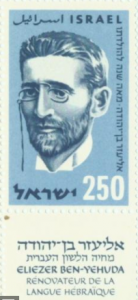 What’s the story of Modern Hebrew – how was it revived, and how’d it come to be a modern national language less than a century ago?
What’s the story of Modern Hebrew – how was it revived, and how’d it come to be a modern national language less than a century ago?

 *Elementary Pre-K to 2nd grade & 3rd to 5th grade sub-groups
*Elementary Pre-K to 2nd grade & 3rd to 5th grade sub-groups Humans acquire languages one way only: By understanding messages, aka, Comprehensible Input (Krashen, Foreign Language Education The Easy Way).
Humans acquire languages one way only: By understanding messages, aka, Comprehensible Input (Krashen, Foreign Language Education The Easy Way).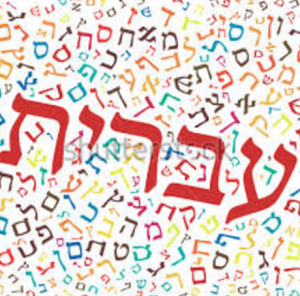 Our rich and diverse liturgical/lifecycle/holiday curricula – hereafter called religious school – explores prayers, songs, religious artifacts, images, communities (including Israel), food, customs, and some texts. Let’s discuss the texts.
Our rich and diverse liturgical/lifecycle/holiday curricula – hereafter called religious school – explores prayers, songs, religious artifacts, images, communities (including Israel), food, customs, and some texts. Let’s discuss the texts.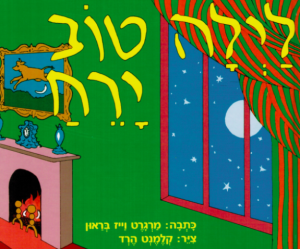 as pre-schoolers (or even earlier these days!) with their native English.
as pre-schoolers (or even earlier these days!) with their native English.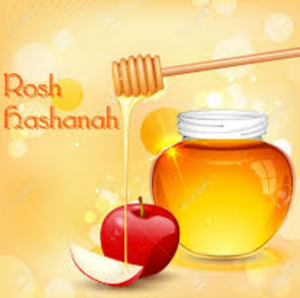 without simultaneously presenting their written Hebrew counterparts in context. But I’m not advocating for isolated word labelling, like we used to see in so many bilingual classrooms in the 80’s – 90’s. I’m talking about contextualized chunks of written Hebrew language, chunks that will be repeated orally throughout the normal course of class.
without simultaneously presenting their written Hebrew counterparts in context. But I’m not advocating for isolated word labelling, like we used to see in so many bilingual classrooms in the 80’s – 90’s. I’m talking about contextualized chunks of written Hebrew language, chunks that will be repeated orally throughout the normal course of class.
 For nearly 25 minutes we spent time in Hebrew trying to track down felafel for our hungry protagonist. First she went to Maggiano’s, our Italian venue, hungrily seeking felafel. I accompanied her across the classroom toward the Maggiano’s poster, where a Maggiano’s representative/classmate was waiting, a luscious slice of (plastic) pizza in one fist, a rubbery beige disc of coiled pasta in the other. I did the talking while my actors silently brought our drama to life. As dramatic director, I coached Leah to rub her stomach, stating that she loves felafel, while the class confirmed that no, unfortunately Maggiano’s doesn’t have felafel. It has pizza, and it has spaghetti.
For nearly 25 minutes we spent time in Hebrew trying to track down felafel for our hungry protagonist. First she went to Maggiano’s, our Italian venue, hungrily seeking felafel. I accompanied her across the classroom toward the Maggiano’s poster, where a Maggiano’s representative/classmate was waiting, a luscious slice of (plastic) pizza in one fist, a rubbery beige disc of coiled pasta in the other. I did the talking while my actors silently brought our drama to life. As dramatic director, I coached Leah to rub her stomach, stating that she loves felafel, while the class confirmed that no, unfortunately Maggiano’s doesn’t have felafel. It has pizza, and it has spaghetti.

